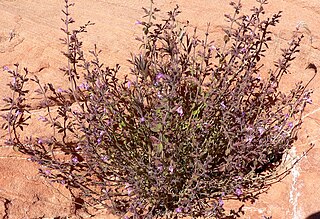
The Nearctic realm is one of the eight biogeographic realms constituting the Earth's land surface.

The Baja California Desert is a desert ecoregion of Mexico's Baja California peninsula. This ecoregion occupies the western portion of the Baja California peninsula, and occupies most of the Mexican states of Baja California Sur and Baja California. It covers 77,700 square kilometers. The climate is dry, but its proximity of the Pacific Ocean provides humidity and moderates the temperature. The flora mostly consists of xeric shrubs and over 500 species of recorded vascular plants.

The Coronado Islands are a group of islands located 13 km (8 mi) off the northwest coast of the Mexican state of Baja California. Battered by the wind and waves, the rocky islands are mostly uninhabited except for a small military detachment and a lighthouse keeper. Despite their barren appearance, they serve as a refuge for seabirds and support a sizable number of plants, including 6 endemic taxa found only on the islands. The waters around the islands support a considerable amount of diverse marine life.

Cedros Island is an island in the Pacific Ocean belonging to the state of Baja California, Mexico. The dry and rocky island had a population of 1,350 in 2005 and has an area of 348 square kilometres (134 sq mi) which includes the area of several small nearby islands. Cedros Island is mountainous, reaching a maximum elevation of 1,205 metres (3,953 ft). The economy is based on commercial fishing and salt production. Cedros has a distinctive flora and the traces of some of the earliest human beings in the New World. The ocean around the island is popular with sport fishermen.

Washingtonia robusta, known by common name as the Mexican fan palm, Mexican washingtonia, or skyduster is a palm tree native to the Baja California peninsula and a small part of Sonora in northwestern Mexico. Despite its limited native distribution, W. robusta one of the most widely cultivated subtropical palms in the world. It is naturalized in Florida, California, Nevada, Arizona, New Mexico, Hawaii, Texas, parts of the Canary Islands, Spain, Portugal, France, Italy, Malta, Albania, Greece, Turkey, Cyprus, Israel, Palestine, Jordan, Lebanon, Syria, Iraq, Saudi Arabia, Bahrain, Qatar, United Arab Emirates, Oman, Yemen, Iran, Afghanistan, Egypt, Libya, Tunisia, Algeria, Morocco, and Réunion,.

Parkinsonia microphylla, the yellow paloverde, foothill paloverde or little-leaved palo verde; syn. Cercidium microphyllum), is a species of palo verde.

Hedeoma is a genus of flowering plants in the mint family, Lamiaceae. It is native to North and South America. They are commonly known as false pennyroyals.

The San Lucan xeric scrub is a xeric shrubland ecoregion of the southernmost Baja California Peninsula, in Los Cabos Municipality and eastern La Paz Municipality of southern Baja California Sur state, Mexico.

Agrostis exarata is a species of grass known by the common names spike bentgrass, spike bent, Pacific bentgrass, and spike redtop. It is native to western North America from Texas to the Aleutian Islands.

Hazardia is a small genus of North American flowering plants in the family Asteraceae. Plants in this genus may be called bristleweeds or goldenbushes.

Bursera microphylla, known by the common name elephant tree in English or 'torote' in Spanish, is a tree in genus Bursera. It grows into a distinctive sculptural form, with a thickened, water-storing or caudiciform trunk. It is found in the southwestern United States and northwestern Mexico.

Deinandra is a genus of flowering plants in the tribe Madieae within the family Asteraceae. Such a genus is not recognized as distinct by all authorities; its species are often treated as members of the genus Hemizonia.

Pachycormus is a monotypic genus of flowering plants in the cashew family commonly known as the Baja elephant tree, torote blanco, or copalquín. The single species Pachycormus discolor is endemic to the Baja California peninsula, with three varieties. This sarcocaulescent tree or shrub is characterized by its unique gnarled growth habit, skin-like exfoliating bark, and succulent nature, whose appearance has been colorfully described as "the proboscis of an elephant holding a nosegay," a "huge radish protruding from the ground," or "grotesque resemblances of the flexed limbs of a corpulent human being." This drought-deciduous species spends most of the year dormant, but following rains pinnate green leaves emerge, and in the late spring to summer the leaves yellow, fall, and give way to bright red, cream, or pink flowers that give it a striking appearance in bloom.

Vauquelinia californica, commonly known as Arizona rosewood, is an evergreen species of shrub or tree, in the rose family, Rosaceae.
A. californica may refer to:

Rhus microphylla, the littleleaf sumac, desert sumac, correosa, or agritos, is a species of sumac in the family Anacardiaceae, native to North America, in the southwestern United States and northern and central Mexico, from central and western Texas, southern New Mexico, central and northern regions of the Mexican Altiplano-(Mexican Plateau), and extreme southeastern Arizona of the Madrean Sky Islands.
Agrostis thurberiana is a species of grass that is native to northwest and southwest United States and Canada.

Brickellia microphylla, the littleleaf brickellbush, is a flowering plant species in the family Asteraceae native to western North America.

Bahiopsis is a genus of North American flowering plants in the tribe Heliantheae within the family Asteraceae. It is native to the southwestern United States and northwestern Mexico, with several of the species endemic to the Baja California Peninsula.

















